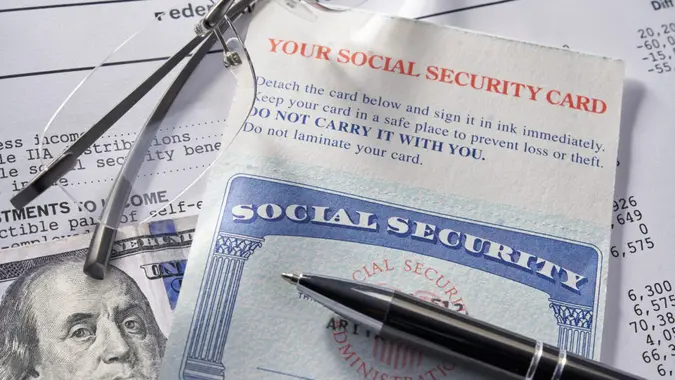How To Create a Monthly Budget As a Couple Living On Only Social Security

Commitment to Our Readers
GOBankingRates' editorial team is committed to bringing you unbiased reviews and information. We use data-driven methodologies to evaluate financial products and services - our reviews and ratings are not influenced by advertisers. You can read more about our editorial guidelines and our products and services review methodology.

20 Years
Helping You Live Richer

Reviewed
by Experts

Trusted by
Millions of Readers
The average Social Security check is $1,907 — that’s $3,814 for senior couples living on Social Security. This might not seem like a lot, but it can go a long way for debt-free and money-conscious folks.
If you’re a couple living only on Social Security, here are some expert-recommended steps to creating a sustainable budget and stretching your money further.
Talk About Your Budget Together
The first step is openly discussing finances with your partner. This discussion should include your individual and joint goals and each’s money needs. It should be judgment-free and as transparent as possible. That way, you can both get on the same page and make a plan — and a budget — together.
Calculate Your Income
You’ll need to know your income to create a budget.
“While it can be hard to create a super precise budget while receiving Social Security payments, you can create a useful budget by getting an idea of what your average income will be and using that to guide you,” said Erika Kullberg, founder of Erika.com, an attorney and personal finance expert.
Keep in mind that Social Security checks vary. If that’s the case for you, account for that.
“If you aren’t confident about how much money you will receive each month, leave a little wiggle room in your budget for months where payments might be less,” added Kullberg. “It’s better to be left with extra money at the end of the month than to not have enough.”
Figure Out and Track Your Expenses
The next step to creating a sustainable budget is calculating your fixed and variable expenses. Start with your necessities so your key expenses are covered first.
“This includes housing, utilities, groceries, healthcare, and transportation,” said True Tamplin, a certified personal finance educator and founder of Finance Strategists. It also includes insurance premiums and, if you have them, debt payments.
Then, consider travel, leisure, clothing, entertainment and dining out. These can vary from month to month and aren’t always necessary. If you don’t have enough money to handle them, you’ll at least rest easier knowing your other costs are covered.
You may find it helpful to track your monthly expenses using a spreadsheet, app or pen and paper. If your expenses do change monthly, add up the past three to six months’ worth and average them out.
For example:
- Month 1: You spend $2,200
- Month 2: You spend $1,800
- Month 3: You spend $2,300
- Average monthly expenditure: $2,100 (all three months divided by three)
Eliminate Certain Expenses
If money’s tight and you aren’t confident in your ability to cover everything, it’s time to start cutting back.
“The best way to stretch your budget is to try to cut as many fixed expenses as possible,” said Kullberg. “Some fixed expenses like a mortgage payment are unavoidable. But things like entertainment subscriptions, gym memberships, and other recurring charges should be considered carefully before giving them a permanent spot in your budget.”
This is again where having an open, honest conversation with your partner helps. By discussing your finances with one another, you can decide what to get rid of — and what to keep — together.
Review Your Budget Regularly
Creating a budget is important, but you can’t let it sit untouched forever. Things change — whether your homeowner’s insurance increases or less food spending. Whatever the case, it’s important to go over your budget every so often to see how things look and where you need to make changes.
“It’s always a good idea to occasionally review your budget to see if you can cut any unnecessary expenses,” said Kullberg. “If you really miss them, you can add them back in, so there’s not a lot of harm in cutting them for a few months to see how it goes.”
Leave Room for Emergencies
Ideally, you’ll already have an emergency fund or some other kind of financial assurance for emergencies. But if you don’t, try to tighten your budget as much as possible. Start setting aside money in a high-yield savings account until you have enough savings to feel comfortable. That way you’ll both be prepared if something happens.
Look Into Senior Resources
There’s no shame in seeking help when you need it. Whether the cost of living rises or an unplanned expense pushes you beyond your budget, don’t be afraid to ask for help.
“Many areas offer food assistance programs for seniors, like Meals on Wheels or SNAP (Supplemental Nutrition Assistance Program), which can help extend the food budget,” said Tamplin.
Other local, nonprofit or government programs help with utility costs, housing costs, transportation and more. If you’re a homeowner, property tax reduction programs are available for qualifying seniors. The exact programs vary based on location.
Implement Other Cost-Saving Measures
If you want your money to go even further, here are a few additional cost-saving measures to try:
- Get involved with the community and see which types of low-cost or free activities and events they offer. There are often senior-focused options designed to enhance quality of life without putting pressure on your budget.
- Use coupons, cashback rewards, discounts and free customer loyalty programs when shopping for groceries and household items.
- Shop for generic alternatives to everyday household goods, grocery brands and prescription medication (with doctor approval).
- Look into patient assistance programs if you’re dealing with expensive medical costs and need assistance.
- If it’s in the cards, downsize or move to a more affordable area for more savings.
- Use senior discounts for things like public transportation, entertainment, and dining out to lower costs.
 Written by
Written by  Edited by
Edited by 

























